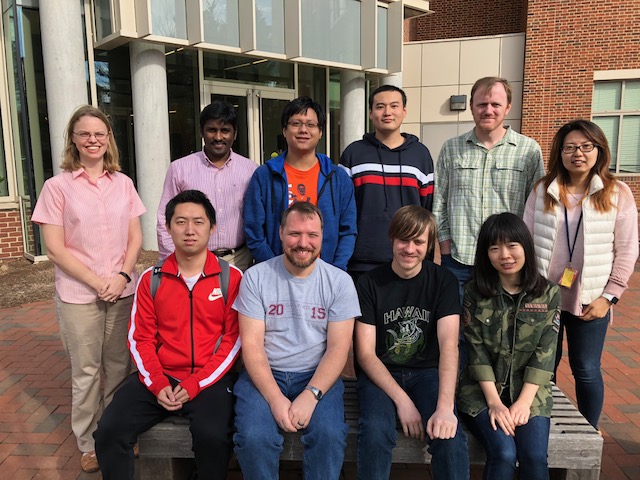1. Introducing the Venton Lab at University of Virginia
Today we feature the lab of Dr. Jill Venton, Professor in the Department of Chemistry at the University of Virginia. Dr. Venton is also affiliated with the Neuroscience Graduate Program and the UVA Brain Institute. Dr. Venton earned her Ph.D. at the University of North Carolina at Chapel Hill, under the direction of Dr. Mark Wightman. Following a post-doctoral research position at the University of Michigan under Dr. Robert Kennedy, Dr. Venton established her research career at the University of Virginia.
2. Venton Lab Research
The Venton lab uses electrochemical sensors to study real-time changes in neurotransmitters in many model system. The lab focuses on both analytical methods development and also applications to studying neuroscience in real systems. For methods development, they have studied many carbon nanomaterial modified electrodes and are designing new, custom electrodes with tunable surface properties. For applications, the Venton lab is a leading group in measuring neurochemical changes in the fruit fly brain and also are studying the neuroprotective molecule adenosine during pathologies such as stroke. A brief list of recent publications in these areas is provided at the end of this article.
The Venton lab primarily uses Fast-Scan Cyclic Voltammetry (FSCV) as the electroanalytical method to interrogate adenosine concentration changes in-vivo. While FSCV is commonly used to measure dopamine and serotonin, it can be applied to other more challenging systems like adenosine, whose electrochemical potential limits are more extreme than other neurotransmitters.
The Venton lab has worked with Pine Research to develop products that are useful to the neuroscience community. They helped design the Malli Adapter to allow the use of traditional electrode holders with Pine Research products, such as the WaveNeuro FSCV Series potentiostats and accessories. Pine Research and the Venton lab have also worked together to design headstages with different gains, which are useful for their carbon nanomaterial electrode work.
3. References
- M. Shin, J.M. Copeland, B.J. Venton, Drosophila as a Model System for Neurotransmitter Measurements, ACS Chem. Neurosci. 2018, ASAP article. http://dx.doi.org/10.1021/acschemneuro.7b00456
- S.T. Lee, B.J. Venton, Regional Variations of Spontaneous, Transient Adenosine Release in Brain Slices, ACS Chem. Neurosci. 2017, ASAP Article. http://dx.doi.org/10.1021/acschemneuro.7b00280
- C. Yang, Y. Wang, C.B. Jacobs, I.N. Ivanov, B.J. Venton, O 2 Plasma Etching and Antistatic Gun Surface Modifications for CNT Yarn Microelectrode Improve Sensitivity and Antifouling Properties, Anal. Chem. 2017, 89, 5605–5611. http://dx.doi.org/10.1021/acs.analchem.7b00785
- P. Pyakurel, M. Shin, B.J. Venton, Nicotinic acetylcholine receptor (nAChR) mediated dopamine release in larval Drosophila melanogaster, Neurochem. Int. 2018, 114, 33–41. http://dx.doi.org/10.1016/j.neuint.2017.12.012
- P. Pyakurel, E. Privman Champaloux, B.J. Venton, Fast-Scan Cyclic Voltammetry (FSCV) Detection of Endogenous Octopamine in Drosophila melanogaster Ventral Nerve Cord, ACS Chem. Neurosci. 2016, 7, 1112–1119. http://dx.doi.org/10.1021/acschemneuro.6b00070
- C. Yang, B.J. Venton, Carbon Nanomaterials for Neuroanalytical Chemistry, in: S. Szunerits, R. Boukherroub, A. Downard, J.-J. Zhu (Eds.), Nanocarbons for Electroanalysis, 1st ed., John Wiley & Sons, 2017: pp. 55–74.
- M.D. Nguyen, Y. Wang, M. Ganesana, B.J. Venton, Transient Adenosine Release Is Modulated by NMDA and GABA B Receptors, ACS Chem. Neurosci. 2017, 8, 376–385. http://dx.doi.org/10.1021/acschemneuro.6b00318
- M. Ganesana, S.T. Lee, Y. Wang, B.J. Venton, Analytical Techniques in Neuroscience: Recent Advances in Imaging, Separation, and Electrochemical Methods, Anal. Chem. 2017, 89, 314–341. http://dx.doi.org/10.1021/acs.analchem.6b04278



